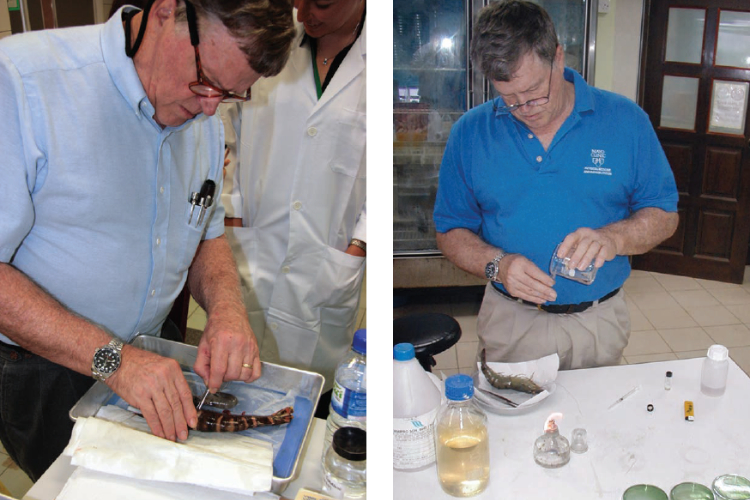Donald-V-Lightner-1945-2021

Prof. Donald V. Lightner, a towering figure in the research of infectious diseases in shrimp, passed away on May 5 in Tucson, Arizona. He will be missed by his family and friends, and colleagues from academia and industry alike worldwide. The world of aquaculture, especially aquatic animal disease specialists, has lost an icon.
In the 1970s, Dr. Lightner put together a team of researchers at The University of Arizona that provided much of the basic knowledge on shrimp diseases and health that enabled shrimp aquaculture grow into a global industry that now supplies more than two-thirds of all the shrimp consumed around the world.
Virtually every shrimp disease practitioner in the world has had some connection with Dr. Lightner and the Aquaculture Pathology Laboratory at the University of Arizona. Dr. Lightner’s contributions were not only in the academic arena, with hundreds of scientific articles, industry reports, conference presentations, graduate students and short courses but also applied directly on his visits to farms around the world.
Without the work of Dr. Lightner and his lab in Tucson, the shrimp aquaculture industry would not be what it is today, a multi-billion-dollar industry supporting the employment of millions of people worldwide. It is because of Dr. Lightner’s pioneering work in shrimp diseases that the price of shrimp moderated to the point that shrimp became the most-consumed seafood item in the United States. Dr. Lightner was at the forefront of developing the science of shrimp pathology, and without that science, shrimp farmers would not have been able to navigate the ever-changing landscape of shrimp health. Time and time again, when a new disease appeared in the shrimp industry, it was Dr. Lightner and his laboratory colleagues who provided the discovery of the pathogen or disease agent, doing so with efficiency when others had failed.
Dr. Lightner became interested in the diseases of aquatic animals when he worked as a trout farm technician for the Colorado Game and Fish Department. The trout farm was suffering significant losses from a common disease of farm-raised trout, so the farm manager began a treatment for the disease without first checking the hardness of the source water. By the time, the “treatment” was complete, several tons of trout had died, and Lightner was assigned the task of burial of those fish. With that background, he focused his graduate studies on becoming a fish pathologist.
In 1971, he received his Ph.D. in Fish Pathology from Colorado State University. He then took a position at the National Marine Fisheries Laboratory in Galveston, Texas, working with the team developing the basics of captive culture of shrimp and began the first shrimp pathology program in the US. In 1975, he moved to the University of Arizona and worked on shrimp health issues at the research station in Puerto Peñasco, Mexico, the shrimp culture display at EPCOT Center in Florida and the Marine Culture Enterprise project in Hawaii. He was part of the team that developed super-intensive culture (>5 kg/m2) of blue shrimp Penaeus stylirostris in enclosed tanks and raceways. During those early days, visual inspection of sick shrimp and histological examination were the basic tools. The Handbook of Normal Penaeid Shrimp Histology (1988) arose from this early work and remains as a primary literature source on histology of shrimp. This book remains the most popular book sold by the World Aquaculture Society, with multiple print runs.
In 1986, Dr. Lightner started the University of Arizona Shrimp Pathology Laboratory. He quickly adapted various other diagnostic techniques from human and animal medicine to address the widening circle of shrimp diseases. He also added expertise to his team with specialists in viral, bacterial, fungal and parasitic infections.
In 1989, Dr. Lightner and his cutting-edge team began offering an on-campus Shrimp Pathology Short Course, open to all that wished to learn the science of shrimp disease diagnostics. By the time he retired in 2015, more than 1500 specialists from 59 countries around the world had been trained. In addition to training people through the Shrimp Pathology Short Course, Dr. Lightner and his team conducted numerous on-site trainings on shrimp pathology in shrimp farming regions around the world. Dr. Lightner was one of the unique few that combined unequaled skills at interpreting shrimp histology slides with the newer technologies provided by molecular science. The knowledge Dr. Lightner imparted to his students in these courses can now be found in every country with a shrimp industry.
His teaching on the subject has prepared the scientific base that has allowed shrimp farmers worldwide to cope with the continual disease issues faced by the industry. As a result of his research and teaching, hundreds of diagnostic facilities have been established around the world, which has greatly reduced epidemic disease losses.
By 1993, the Aquaculture Pathology Lab became a Reference Laboratory for the World Organization for Animal Health (OIE). The Lab was also certified by the USDA and has provided diagnostic service to the global industry, accepting hundreds of samples per year. As part of that history, the Aquaculture Pathology Laboratory has archived case reports of shrimp disease sample workups by Dr. Lightner and his colleagues since the 1970s. These tens of thousands of cases provide the most complete record available for epidemiology of shrimp diseases.
Creation of Specific Pathogen Free (SPF) shrimp stocks has been possibly the single most important technological advance in shrimp farming history. As a crucial team member of the US Marine Shrimp Farming Consortium, Dr. Lightner provided guidance in developing protocols for the creation of the very first SPF stocks of Pacific white shrimp, supported by the analytical capacity to screen for virus-free stocks. The shrimp stocks that came out of this program under the guidance of Dr. Lightner provide the basis for most of shrimp farming today, whether it be directly from those stocks he developed or that others developed using his methods and techniques. Without SPF stocks, the shrimp industry would not be successful today. The application of genetics to shrimp breeding that plays such an important role in reducing costs of shrimp production would not have been possible without a SPF shrimp population. With the development and distribution of SPF shrimp stocks, world production jumped from 1.0 million tons in 2000 to 3.5 million tons in 2010. This incredible story would not have happened without the contributions of Dr. Lightner.
EDITOR: This tribute was compiled and prepared by George Chamberlain, Robins McIntosh, Arun Dhar and Kevin Fitzsimmons. Dr. Lightner received the Honorary Life Award from the World Aquaculture Society in 2007, the highest honor bestowed by the Society.
Here are some quotes from different people around the world:
I would like to thank the World Aquaculture magazine for the opportunity to share some memories of my husband and boss of 43 years, Dr. Donald Lightner. First, my memory of how much he cared for the people that were on the Aquaculture Pathology Lab (APL) research team will always be forefront. The APL team was part of his “family” and the efforts he put forth to keep everyone funded year-over-year were admirable. Without the expertise of the APL team, the lab would not have been as successful as it was.
Don loved teaching and mentoring, and he was good at it. His contributions of knowledge and expertise were of great benefit to the world of aquaculture. I am proud to look back at our careers and remember the impact Don and his team made. His love of travel and all the people that he met along the way was exciting to him. Don’s work was his life.
His diagnosis of dementia was sudden, and the realization that he needed to retire was devastating to him. Don’s form of dementia left him non-verbal so he was not able to keep in contact with those who had become so dear to him over the years. I imagine this was very painful to many of you as well. On behalf of Don, I would like to thank the aquaculture world for all your support, kindness, knowledge and friendship throughout his career. He loved, appreciated and missed all of you very much over these past six years. On behalf of our family, thank you for embracing Don and I over the years. I will be forever grateful. Wishing you all the best. Please consider contributing to the Alzheimer’s Disease Research Center at Mayo Clinic (https://philanthropy.mayoclinic.org/donateMC) or your own local Alzheimer’s Association as a tribute to Dr. Donald Lightner.
— Rita Redman-Lightner
Don had a unique combination of state-of-the-art skills in research, personal experience with commercial production and love of teaching. This mix enabled him to apply sound science to identify causative pathogens, recommend commercially appropriate and practical solutions for preventing and managing outbreaks, and convey information in a way that was clear and understandable. His knowledge and skills allowed him to work with simple, basic tools to achieve major breakthroughs like discovery of new diseases and development of SPF stocks. Just as Lance Armstrong said “it’s not about the bike,” Don would probably say “it’s not about the lab.” In the hands of a skilled pathologist, even a modest lab can deliver crucial advancements.
This anecdote illustrates how he used simple tools to conduct world-class research. Considering all that he had accomplished, his research facilities were remarkably humble, but kept neat and clean, except for one aquarium that was totally green and not cleaned. The aquarium supported a population of algae and amphipods (tiny crustaceans) in a balanced ecosystem. His team subsequently packaged up a sealed container of the algae and amphipods and sent it to NASA, which put it on a space shuttle that went to the Mir space station. After orbiting the earth a number of times, the container was brought back to earth, sent back to Arizona and the amphipods examined histologically by Dr. Lightner’s team. They concluded that the amphipods reproduced normally in zero gravity, which has a number of far-reaching implications. He said modestly, as if anyone could turn their aquarium into a space project, “that’s why we didn’t clean the aquarium.”
— George Chamberlain
He was always the go-to man for an unknown cause of why shrimp die or were not performing well. Maybe he should be best remembered as the “first and foremost shrimp detective of our era” and the most critical person for lifting shrimp farming from a total casino to what is shaping up to be a science-based industry. When I had a problem that could not be explained by management, I never called a ghostbuster — I called Dr. Lightner “the shrimp pathogen buster” and he never let me down. A pure genius with a microscope in what he could find and later on a genius in learning to translate those observations to state-of-the-art diagnostics.
— Robins McIntosh
A reserved person with a keen sense of observation. He transformed infectious disease research in shrimp with a simple microscope and his extraordinary ability to study diseases at an organismal level. His early career days working with shrimp industry professionals enabled him to realize the translational value of his work that ultimately played a pivotal role in bringing the industry from a backyard farming effort to a global industry, as it stands today. It’s a privilege and honor for me to continue his legacy of research and service to shrimp industry globally and take it beyond where he left.
— Arun Dhar
Don was a friend and colleague. Our first joint encounter was working on the revision of WAS Shrimp Pathology Manual in 1997. Don worked with me in Rome for a month, where we had lots of time to talk about aquaculture, shrimp and other things. Then we also used to regularly meet 2-3 times a year in Paris, for many years, when we were members of the OIE Fish Disease Commission. We associated closely for years in our professional capacity and as friends. We will miss him, remember his legacy and cherish good memories in the years to come. — Rohana Subasinghe
Don was the third person I met on my first day working at the University of Arizona in 1981. He showed me around the lab and introduced me to the team. Over the next couple of years when I introduced myself to aquaculture people as being from Arizona, their first response was always “Oh, so you work for Don Lightner.” When I would say “No, I work on tilapia”, they immediately lost interest. So, instead I just said yes, and saved the conversation. Over the next 35 years I did have plenty of collaborations with Don on research, guest lecturing in his class and jointly mentoring graduate students. Don’s humble nature, loyalty and giving credit and sharing opportunities with his team was returned with many staff working their entire careers with him, often turning down lucrative offers from outside. Don was the epitome of what it means to be a professor and scientist: developing valuable new knowledge, sharing it and training others how to use it.
— Kevin Fitzsimmons
For Hawaii, he was there at the beginning of shrimp farming with Marine Culture Enterprises, and he and Jim Brock worked closely to define the significance of viruses in shrimp culture. He continued to help us through his lab at the University of Arizona, as Specific Pathogen Free broodstock began to emerge as a viable commercial option. SPF shrimp proceeded to grow into the industry it is today for Hawaii, over $20 million in annual sales. Don and his career-long commitment to shrimp aquaculture were instrumental to our successes.
— John Corbin
My first encounter with Dr. Lightner was in 1998, when I participated in the well-known Shrimp Pathology Short Course held by the Aquaculture Pathology Laboratory. That short time was enough for me to realize the vastness of his knowledge. That realization of the immense knowledge struck me and formed my resolve to pursue a Ph.D. degree in his lab.
My mental picture of Dr. Lightner is always of him on the microscope, sitting for long hours looking at shrimp samples sent to UA-APL from all over the world. It was in that way that he discovered numerous novel pathologies that had global impact on the shrimp industry. During the short course, he explained how a shrimp virus (IHHNV) was shaping the future of shrimp farming and it made me realize that Dr. Lightner and his work likewise shaped the shrimp industry worldwide and served as the counterbalance to all these emerging diseases. He has influenced our present knowledge of shrimp diseases that serves as a vital tool on how management strategies are formed. Attesting to this are the numerous books and research articles he published and the diagnostic methods he developed that are being applied worldwide. Due to these same realizations, I found my way back to the laboratory where I can continue to contribute to his legacy.
— Luis Fernando Aranguren Caro
This photo says everything about him: his dedication, passion, commitment, hard work, quiet and unassuming way of getting about his work and taking care of things hands on. I was in awe of the man who was regarded as the father of shrimp pathology and he was very simple, unassuming and cordial. Don, George Chamberlain and I were once invited to the Philippines to speak at a conference. When we arrived at the Bacolod airport, we found this large banner that welcomed the three great scientists visiting to attend the conference. Later, during the gala dinner, I was given a few minutes to speak and I narrated a Tamil saying that “the string that is used to tie flowers also gets some of the flower’s smell” and that I was the string enjoying a moment of fame due to the proximity to the two greats. Our aquaculture sector is fortunate to have had more than a few greatest of the greats. People who were deeply committed, utterly passionate, and advanced the sector through sheer hard work. Don’s passing away means we have one less today and he will be dearly missed.
— Arul Victor Suresh
His life could be best described with one word: dedication. He was the first to get to the lab and the last to leave, day in and day out. He was a humble genius but didn’t want to make any noise. I have seen him being attacked by others, but he did not care and just looked ahead and remained calm. He told me, “Loc, you should not care about what people may say about you. You need to focus on your work and the quality of your service.” I learned discipline, dedication, professionalism and the work ethic from him. He had a great sense of humor. Sometimes, he just stopped by my desk to tell me a joke. He was a very helpful mentor, but at the same time, he was so easygoing to be a friend. I told him about my plan of building a diagnostic lab and a research center in Vietnam and asked him for advice. He said “Loc, this can be your lifetime project, and you have to carefully think about this. This can stick to you the rest of your life.” He didn’t mention his career, but I understood what he said implied that he had been working tirelessly for close to 40 years. His work has been so fundamental for the global shrimp industry.
— Loc Tran
Don had a knack for finding ways to improve on everything, always pushing for that extra mile. Having finished what I considered to be the final revision to my dissertation, Don suggested an additional chapter to include data from a related study I had just recently completed. This meant long nights analyzing results and writing to meet the fast-approaching graduation date. However, seeing the improvement and completeness of it, once the job was done, gave me an added sense of accomplishment and satisfaction, which would have been missed otherwise. This is just an example of his dedication to his work and his students. I will always be grateful to him for nudging us to be better and continue improving in our profession.
— Carlos Pantoja-Morales
I did two rounds of visiting research in Dr. Lightner’s laboratory in 1995 and 1996 and participated in his shrimp pathology training courses. Don was a gentlemanly and humorous scholar, a low-key and amiable person. I remember that he gave me a sealed small envelope as a gift before I left Tucson in 1995 and told me there was a rattlesnake egg inside. When I received it from his hand, it sounded with bouncing voices and shaking in my hand. That really made me startled. After I opened the envelope, I found it actually was a combination of a rubber band and a hairpin. He was happy and laughing.
— Jie Huang
He took the time to coach and share any information he had. He gave me a simple protocol to determine the density of a hepatopancreas by dropping them into different sugar solutions. This is before I knew about looking at the tubules for lipids, but this simple test spurred me and the team to look at tubules and begin grading them some 20 years back, before it became routine when looking for EMS or EHP.
— David Leong
Dr. Lightner visited RGCA headquarters, the Aquatic Quarantine Facility (AQF), and the Lv-BMC, Domestication of Tiger Shrimp (DTSP) in Andaman and offered valuable suggestions. His remarkable contribution for designing DTSP-NBC based on biosecurity aspects is highly remembered. He contributed good biosecurity inputs in making our Central Aquaculture Pathology Laboratory (CAPL), which is presently running as one of the successful aquaculture pathology labs in India.
— Dr. S. Kandan and Dr. Anup Mandal
He will continue to have his presence with us through his innumerable scholarly articles and immensely recognized contributions. He will be remembered for generations to come as the torchbearer of shrimp pathology. — Dr. K. V. Rajendran














